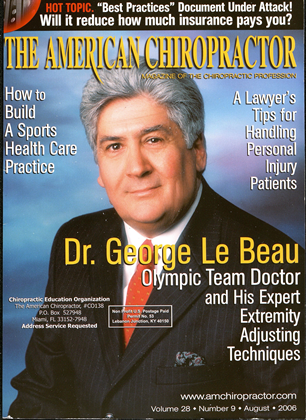Reader Not Convinced Dr. Tedd Korcn titles his technique article "Do Cranial Bones Move? (Ask the Italians)" in the June 2006 issue of The American Chiropractor. He does not address the question in his article, however. Except for directing us to "the Italians" (whoever they are??), there is nothing particularly convincing in this article to substantiate any significant motion of the cranial bones across the sutures. I don't read Italian and do not appreciate being directed to some "secret research" locked up in Major DeJamette's se- cret vault somewhere (the other answer I get when I ask for details about some esoteric technique). If there is evidence of cranial bone motion, then present it. There is a lot of motion at the TMJ by those promoting techniques for treatment of cranial bone problems, but I am not aware of anything that would pass for scientific investigation of motion of skull bones, at least not in the last seven decades. The issue should not be hard to resolve for those who are promoting cranial techniques—there arc exquisitely sensitive motion detecting devices available that would provide a clear yes/no on the fundamental question that Dr. Koren asks in his article title. The burden of proof is on the guy with the theory; it is not the job of science to disprove every crank with an idea—that's the way science works. If chiropractors want to sell correction of cranial motion patterns on a fee-for-ser-vice basis as health care, then let's see some evidence. First, establish that there is actually significant motion between the bones that these techniques are supposedly addressing. After that, make some connection to CSF circulation, or whatever else you think it affects. Jeff Thompson, D.C. Dr. Tedd Koren responds: I suggest Dr. Thompson re-read my paper, especially where I wrote: Recently, original research on live monkeys and sections of human skull (containing sutures) demonstrated objectively that the cranium moves in a rhythmical manner. Additionally, the sutures, when viewed under high-powered microscopes, rather than being fused and filled with calcified tissue are patent or open and contain connective tissue, nerve tissue and blood vessels. (Retzlaff EW, Michael D, Roppel R and Mitchell F. The structures of cranial bone sutures. Journal of the American Osteopathic Association. 1976:75:607-608.) I think Dr. Thompson would find Ret-zlaff's paper most enlightening, since it objectively demonstrates cranial motion movement. However Retzlaff's paper is just one among others that deal with this subject The changes in health after cranial corrections are well documented. I refer the good doctor to Liem T. Cranial Osteopathy Principles and Practice 2nd edition, Edinburgh: Elsevier Churchill Livingstone 2004:29-30, the great osteopathic cranial pioneer William Sutherland, Dr. John Upledger (developer of CranioSacral Therapy) and others who have discussed this subject in great detail. I especially would direct Dr. Thompson to classes taught by the Upledger Institute (some are one-day classes) and by various cranial osteopaths. Many tens of thousands of practitioners are able to actually feel the rhythmic movement of the cranial bones and—in the case of various health conditions—the non-movement of the bones. The more I practice cranial analysis and correction via Koren Specific Technique (KST), the more I am amazed at how cranial bones can affect health. For example, when the temporal bones are locked, people often suffer from vertigo, hearing problems and a host of auditory problems which resolve immediately after a cranial correction (adjustment). The same is true for the sphenoid which, when locked, is related to depression, insomnia, "brain fog," hormonal problems, dyslexia and many other conditions. Tedd Koren. D.C. Dr. Ulan Continues to Get Rave Reviews! Bravo to your magazine. I just read the article by Dr. Freddie Ulan on "Preventing Recurring Sublux-ations with Nutrition" in the May 2006 issue. This is SO TRUE. I have been a practicing chiropractor for twenty years and was frustrated for almost half of those years. I always considered myself to be reasonably proficient at my profession and could never understand how the "old guys" in chiropractic could "cure" patients in just a few treatments when it was taking me twenty or thirty or more-than-I-like-to-admit treatments to get the same results; or why "Patient A" got better results and with fewer treatments than "Patient B" did with the exact same condition. Then I met another chiropractor at a seminar that told me it was quite simple, actually. The answer was NUTRITION. I started on my quest to learn more, and how right she was! The chronic "chiropractic invalid" patients are so devoid of the building blocks necessary for their bodies to heal that they are never able to overcome that chronic state. The problem I had was finding the right supplements for each patient without bombarding them with a sack full of vitamin bottles or giving them the "Try this one. Okay, that didn't work, so try this one." method. Thank you again for the article. This type of information may be able to help many of our colleagues help more of their patients get well. Please have more articles like this in your magazine. I would like to hear more from Dr. Ulan, too. Charles P. Fleming, D.C. I was very excited to see the article in your May issue written by Dr. Ulan. I like reading articles about the relationship between nutrition and the effect it has on the spine and our overall health. I use Nutrition Response Testing in my practice and Dr. Ulan's system of analysis has transformed my practice and greatly increased my ability to get chronically sick people well—especially with regard to those chronic musckuloskeletal problems that never resolve with chiropractic alone. Thanks, again, for the article and please continue to print related articles in the future. Brian P. Walsh, D.C. ur. uian s Nuirmon response testing "■ a, . U BODY SCAN CHART ■
 View Full Issue
View Full Issue






